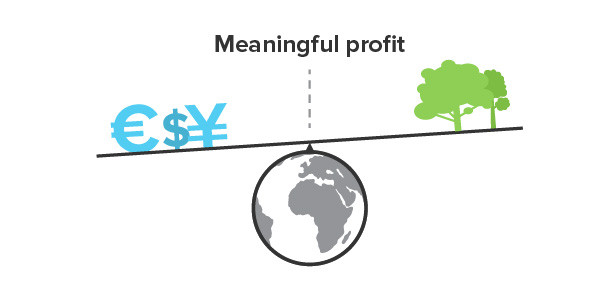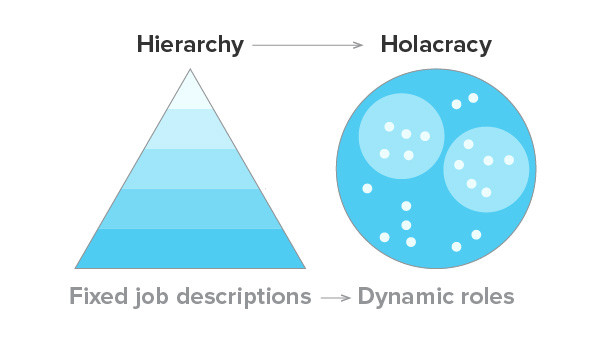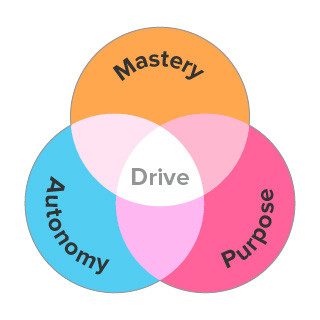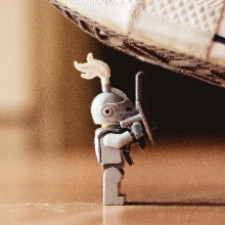What is holacracy and how does it work?
Holacracy is a business model based on decentralized control and autonomous leadership. The concept was introduced in 2007 by Brian Robertson and Tom Thomison, but only became widely known when Zappos embraced and implemented the model.
As the inventors put it, holacracy enables employees to make meaningful decisions in pursuit of the company's goals. But not everyone is equally enthusiastic about the promising model. When Zappos announced the model, employees were given the choice of embracing it or resigning for pay. Approximately 14% of all employees left the company.

Why do we need a new model like holacracy?
Robertson and Thomison weren't the only ones after the turn of the century who said that there was something fundamentally wrong with how we learned to set up a company. The traditional hierarchical management model, according to many, leaves a lot of talent and knowledge unutilized within the company.
Eckhart Wintzen founded the company BSO in 1973 and then implemented the cell division concept. BSO had 10,000 employees in 20 countries, and each company had its own independent cell that operated completely autonomously.
Eckhart found every form of hierarchy efficiency and a loss of capital. He was one of the forerunners in this new way of thinking, and his cell division concept resembles holacracy in many ways.
In 2011, Ben Steenstra and Wassili Zafiris published "Ik BEN niet alleen op de wereld". This book is about the golden mean between the profit and non-profit sector. This is what they call Meaningful Profit. This book also explains why traditional organizational models no longer work.

According to the meaningful profit model, people must now adapt to the machine, whereas the machine should actually adapt to human nature to exploit the maximum potential of each individual.
The essence of holacracy
In essence, holacracy assumes that everyone can function autonomously. Nobody needs a boss to get things done. Instead of a fixed job description, everyone is given a dynamic role that is adapted when needed.

The biggest differences between traditional organizational models and holacracy
- No job description but a dynamic role due to logically changing circumstances and needs.
- Instead of delegated authority there is a distributed authority.
- No large reorganizations but continuous reorganization to be able to keep up with the developments.
- No agreement by internal politics, but transparent rules
The philosophy behind holacracy
In daily life, no adult person needs a boss to obey the rules of society. Almost everyone knows the limits of what is and isn't possible and also knows his own limits. If you have never bought a house before, ask the advice of a real estate agent. And if you want to go to work, don't take your neighbor's car with you.
There is order in society without bosses. We take care of things ourselves. We all are leaders and followers, depending on the role we play and the situation we find ourselves in. Actually, you can do anything you want, provided you don't harm anyone else. That is essentially holacracy.
What is the advantage of holacracy?
Within a hierarchical enterprise, making decisions is often difficult and time-consuming because the decisions are made centrally. Because of individual freedom, decisions can be made faster.
Responsibility no longer has to be given but is taken on an individual level, which promotes creativity. Holacracy assumes that each individual is capable of making decisions and acting in the interests of the company.
The philosophy of author Daniel Pink that people are motivated and driven by autonomy, mastery, and purpose within their work, is fully anchored in Holacracy. The theory is, therefore, that employees become happier, more efficient, and more creative from a holacracy.

What are the disadvantages of holacracy?
Robertson and Thomison argue that we should look at the human body to understand and embrace holacracy. Every cell in our body works independently of the others and serves its own purpose.
And that is exactly where the model can go wrong. A few cancer cells can destroy an entire body. That makes the dependency of the complete body on those few nasty cells very high.
Not every individual can cope with the responsibility that holography carries at an individual level. There are many (self-declared) leaders, but not every leader has sufficient skills and talents.
Holacracy also requires a company with a clear vision, mission, and strategy. If this is not completely clear and is embraced by every individual, it is an impossible task to contribute meaningfully.

This means that holacracy is liberating for some individuals, companies, and cultures and not for others.
-
Ben SteenstraCo-founder of TheONEFree
-
Wassili ZafirisCoaching, Training€ 3,23 pm
-
Hensin AinnsChange Management€ 0,04 pm
-
Retha Bookerteam leader€ 0,05 pm
-
Adger de BoerCoach & adviseur€ 2,57 pm
-
Fabio RomanoProfessional Coach€ 1,15 pm















